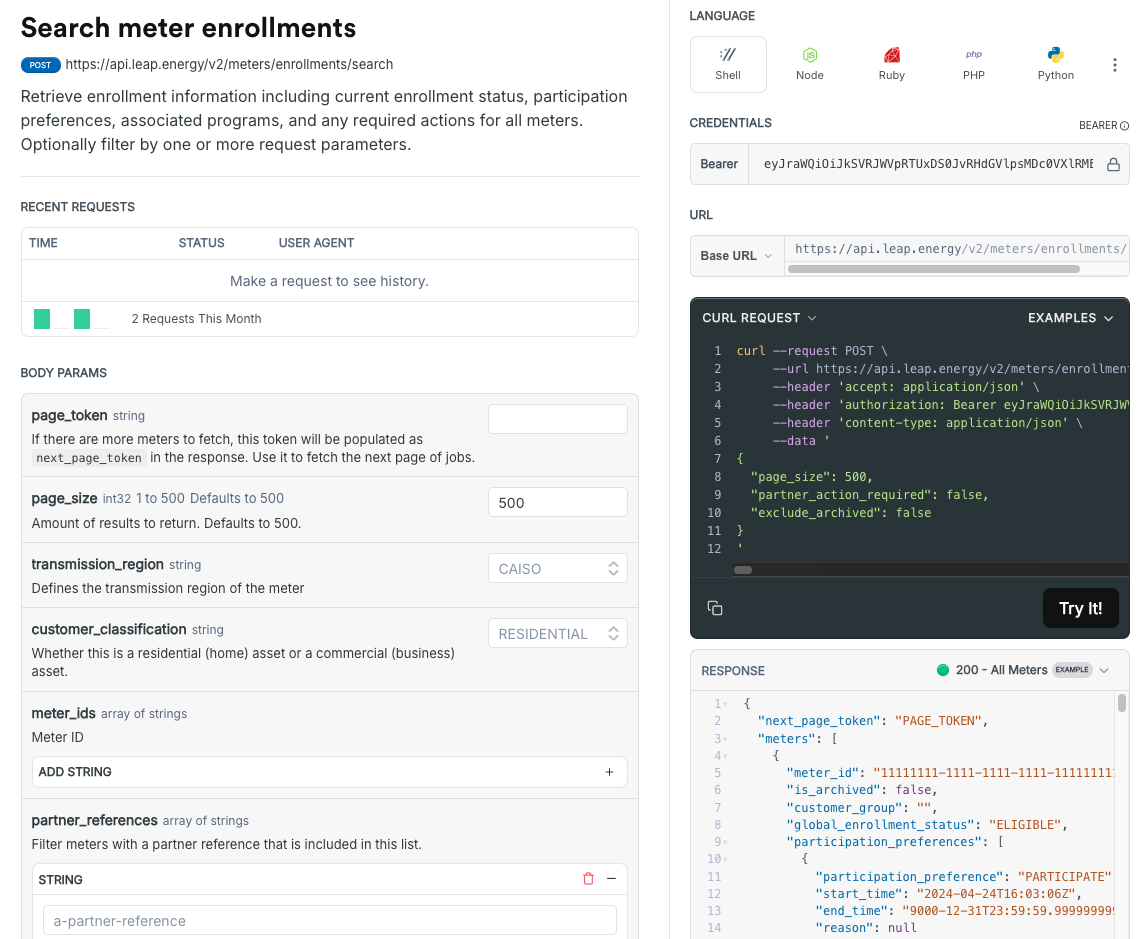Getting Started
Outlined below are 4 key considerations to keep in mind when planning for and making API calls to the Leap endpoints.
New to Leap?The Leap Platform Overview guide within the Getting Started section of the Leap Knowledge Center (Portal credentials required - see #1 below) provides an overview of the Leap platform, tools and documentation available.
1. Leap user account
Your Leap user account credentials are required to log into the following:
- Partner Portal (Production | Staging) Can be used to validate data within your account (e.g. connections, meters, dispatch events, performance, revenue). NOTE: your same credentials will work in both Production and Staging.
- Partner Account page (Production | Staging) Page within Partner Portal to view/manage API keys, invite new admin users, manage permissions, etc.
- Knowledge Center View Leap platform guides as well as market and program-specific operational guides.
- Login API endpoint Get a bearer auth token for subsequent API calls. NOTE: this is not needed if you are using an API key instead.
Getting Access:
Once Leap has created your partner account on the Leap platform, the initial admin users are invited to create their credentials for accessing the platform. See the callout below for managing user access and inviting additional admin users. Reach out to your Leap account manager or [email protected] if you don’t yet have an account and need one created.
Invite Additional Admin UsersOnce you have your user account, you can invite additional users and mange their permissions in your Partner Account page. Inviting users in this Production partner account page will automatically give them access to the Staging environment as well.
‘Manager’ role has full admin access whereas the ‘User’ role does not have the ability to manage the account settings (e.g. invite/delete users, create/revoke API keys). When users are added, an automated email is sent with a link to create their password. This link expires after a few days. If this happens, simply delete their account on the Users tab and re-add them.
2. Staging vs. production base URL
Decide whether you want to make a call in the staging or production environments:
- Production: https://api.leap.energy/
- Staging: https://api.staging.leap.energy/
3. Bearer token for authentication
All requests to the Leap API endpoints must include a valid Bearer token in the HTTP Authorization header. There are 2 methods for obtaining this token:
- Login Based Authentication - Using your Leap credentials from #1 above
- API Key Authentication - Can be created on your Partner Account page (Production | Staging)
POST /v2/meters/enrollments/search HTTP/2
Accept-Encoding: gzip
Host: example.com
Authorization: Bearer eyJhbGciOiJIUzI1NiIsInR5cCI6IkpXVCJ9.eyJ1c2VyX2lkIjoiOWIxODc2YzEtMTk5Yy00ZjRjLWJmYjEtNWZkMTEzM2M1MGJjIiwiYWNjb3VudF9pZCI6ImJjZjc1YWQ3LTE5OWMtMTk1NC1iZmIxLTVmZTExMzNhNTBiYyIsInBlcm1pc3Npb25zIjpbIlJlZ2lzdGVyTWV0ZXIiLCJHZXRNZXRlciIsIkRlbGV0ZU1ldGVyIiwiUGxhY2VCaWQiLCJHZXRCaWQiXSwiZXhwaXJhdGlvbl9kYXRlIjoiMjAxOC0wNy0wOVQxMzoxNjo0N1oifQ.6WQXgno7zU9lrn0IeZYMSoYGNTHUi26m6S5grSGHfEI
403 Errors - Production vs. StagingAPI keys (and login-based auth tokens) are scoped to production or staging environments separately so make sure you are creating your key in the appropriate environment in which you want to use it. You will receive a 403 error if the key (or login-based auth token) is invalid.
4. Submit initial calls from your browser
Choose the endpoint you want to use on the API Reference tab by drilling down in the left panel to see the list of endpoints within each meter journey phase. After selecting an endpoint, the middle panel includes request parameters and response body descriptions. The right panel shows a response example but it also allows you to submit calls using the 'Try It' button.
Simply follow these steps to test from within your browser:
- Under the CREDENTIALS section on the right, add your auth token from #3 above (API Key | Login Authentication) into the Bearer field
- Under the URL section on the right, choose the the Production vs. Staging base URL
- If applicable or required, enter any QUERY, PATH, or BODY PARAMS in the middle panel
- Click the ‘Try It!’ button to see the output in the RESPONSE box at the bottom of the right panel
Auto-Populated Bearer TokenWhen logged into the Partner Portal and making calls from the browser in this developer portal, your Staging token is automatically populated. However, for Production calls, a valid production bearer token (API key or login token) must be used in the CREDENTIALS box instead.
Endpoint Example (middle and right panels):

Updated 2 months ago